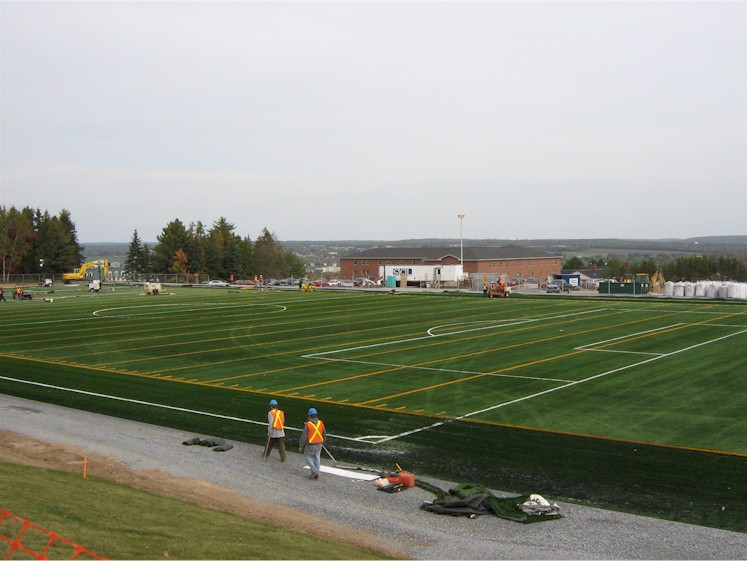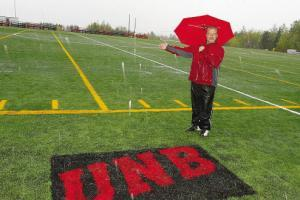
|

|
|
TURF’S UP: University of New Brunswick athletic director
Kevin Dickie invites fans to come out to UNB’s Chapman Field, which is ready
for action regardless of weather conditions. The Varsity Reds men and
women’s soccer teams will play their first games on the field today, hosting
the Cape Breton University Capers at 1 and 3 p.m.
|
Turf field at UNB was much needed -- Dickie
By BILL HUNT
hunt.bill@dailygleaner.com
Published Saturday October 13th, 2007
Appeared on page B3
The University of New Brunswick Varsity Reds get to officially roll out the green carpet this weekend. The new $1.7 million state-of-the-art FieldTurf surface on Chapman Field, installed with just minutes to spare before the start of the Sony Cup Under-18 Canadian soccer championship tournament last week, will debut as the home of the Varsity Reds men's and women's soccer teams today. The women take on the Cape Breton Capers at 1 p.m. with the men to follow on the shiny new pitch at 3 p.m. Though it came down to the 11th hour to get it done in time for the Sony Cup -- workers were there around the clock for the two weeks leading to Sony Cup kickoff even though UNB was under no obligation to finish by that deadline -- UNB athletic director Kevin Dickie said it was a project more than two years in the planning. "It goes back as a need for UNB for a while," he said. "When I got here, I was handed a file ... it had napkins and matchbook covers ... but it really had no relevance in moving the project forward. It needed some attention." Dickie decided to pay it some attention. He put together a business plan, the key elements of which were already in place by the time the host V-Reds won the AUS championship in the mud and muck of "old" Chapman Field last November. While UNB prevailed to win the championship in a quagmire, Dickie said the messy pitch "didn't hurt our cause." It actually helped in one sense, in convincing the university fathers that "this could really help the university. We want to be a place where the community and the region and the nation are excited to be. It was a matter of making the dollars work." The FieldTurf is only one aspect of the project. There will be lights. A bubble to enclose a portion of the field. A clubhouse. A score clock. Dickie "isn't comfortable" revealing a final cost on the whole project. The FieldTurf is top of the line. "We had a couple of things that we weren't going to compromise, and one of them was the quality of the field," he said. "If you're going to spend a lot on a vehicle, you're probably going to want to pimp your ride." Dickie sees it as a home for UNB's soccer program, of course, and other varsity programs and campus recreation. The Fredericton District Soccer Association, Capital Area Minor Football. Ultimate Frisbee. Rugby. Lacrosse. Indoor golf. And if you and a bunch of your buddies want to play touch football under the lights some night, there's provision for that too -- at prices cheaper than are available elsewhere at the other turf facilities in the province. "The continual search for partners will not stop," he said. "But you have to build it before they come. People have to get a sense of what they're opting into." It's Dickie's and UNB's field of dreams. But he said working with the city, in particular with recreation director Wayne Tallon, was "seamless and easy. I can't say enough good things about our relationship with the city and how well we worked together to accomplish something that was important to both of us." Life expectancy of the surface is 10-15 years. Whether there will be a UNB football team taking to that surface is a question Dickie expects the administration will be able to answer "by the end of the fiscal year." For now, the football lines on the field are a tribute to the diligence of Capital Area Minor Football Association Past President Terry McIntyre. "It just boiled down to 'What can we do to be a part of this thing, and what can we do to make it happen?' " said Dickie. "It's that type of attitude that gets the orange lines every five yards on a field." They need the same kind of energy -- on a grander scale -- to bring back UNB football. "In my first two weeks as AD here, I was bombarded more about a sport we didn't have than sports that we do." Dickie has done some research, contacting 11 schools across the country to determine what it would cost to run, not just a program, but a winning program. Operating budget is "over a quarter of a million dollars every year," he said. Startup costs "depend on a lot of different things. We have the surface, but do you have the infrastructure around it? The business plan would depend on how many people you could put in. If we're counting on this many people, could you put that many stands in?" The analysis aspect has been completed. Now it's in the hands of "some of the people that are energized about having football here at UNB," Dickie said. Dickie is reluctant to reveal how many and who they are, but they're investigating partnerships with alumni, the business community, the community at large and the university to see whether a relaunch is viable. "At the end of the day, there's not going to be any grey," he said. "It will either be black or white. But what we'll be able to do, finally, for the first time since 1980 is say 'It doesn't work here at UNB' or 'Maybe this can work.' I would think that by the end of our school year, we'll have a pretty good idea." |
|
UNB to partner with city on new
'turf' field
A weekend of soccer play at University of New Brunswick's
Chapman Field was a good reminder of why the university decided a year ago to
embark on a redevelopment plan to install artificial turf at the facility. FDSA talking with city about switch to 'turf' A committee representing the Fredericton District Soccer
Association has met with officials from the city to present a "usage
plan" detailing how much and how often they would use the proposed new
Field Turf surfaces which are to be installed at UNB by next June.
Soccer enthusiasts read on ... city to improve field
conditions for players
hmclaugh@dailygleaner.com
Published 2006-12-26 | Page A5
Fredericton city council has put its money where its mouth is.
The city has committed to purchasing 3,000 hours of time on an all-season artificial turf athletic field to be built by the University of New Brunswick. The cost to city taxpayers will be $165,000. "We have reached an agreement with the University of New Brunswick," said finance committee chairman Dan Keenan. The construction of artificial turf fields will allow soccer, ultimate frisbee players and other sports groups to have access to better play surfaces, Keenan said. "This is a beautiful opportunity for us to provide better facilities for the users and to partner with the university," said community services director Wayne Tallon. "Right now we're waiting for them to make the official announcement that they will build the facilities. Hopefully we'll have them up and running by next summer." The city commissioned a review of its own sports play fields from Amulet Consulting. That report gave only passing grades to many of the grassed fields the city owns. Excessive play makes it tough to keep the fields in good shape and restricts the length of the play season, the consultant noted. Soccer, one of the fastest growing sports in the country, has been lobbying for better Fredericton recreation fields because of the growth in its membership. In 2002, the Fredericton District Soccer Association entered into an agreement with the city to develop lands for use as a soccerplex. According to the organization's 2006 annual report, it spent $40,407 on the development of a site for a soccerplex, including clearing lands for the preparation of fields. "Because of new developments regarding the soccerplex location the city returned the entire amount spent on this site," said treasurer Karen Grant in the annual report. The soccer group also donated just over $10,000 to improve fields so it could meet regulation standards. |